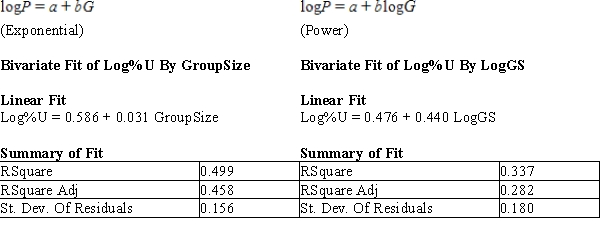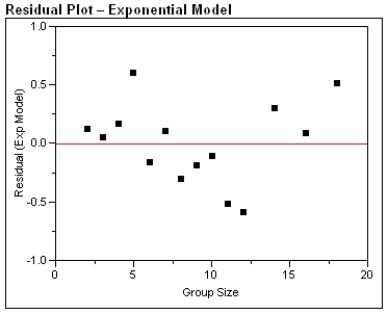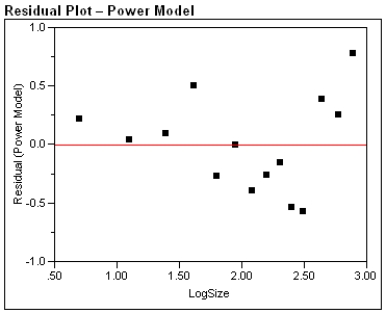One of the problems when estimating the size of animal populations from aerial surveys is that animals may bunch together, making it difficult to distinguish and count them accurately. For example, a horse standing alone is easy to spot; if seven horses huddled close together some may be missed, resulting in an undercount. The relative frequency of undercounts is typically reported as a percent. For example, if there are 10 horses in a group, a person in the plane may typically count fewer than 10 horses 20% of the time. In a recent study, the percent of sightings that resulted in an undercount was related to the size of the "group" of horses and donkeys; the following data were gathered:  After fitting a straight line model,
After fitting a straight line model,  , significant curvature was detected in the residual plot, and two nonlinear models were chosen for further analysis, the exponential and the power models. The computer output for these models is given below, and the residual plots follow.
, significant curvature was detected in the residual plot, and two nonlinear models were chosen for further analysis, the exponential and the power models. The computer output for these models is given below, and the residual plots follow.  Residual Plots
Residual Plots 



a) For the exponential model, calculate the predicted log (%undercount) for a group size = 10.
b) Use your calculations from part (a) to predict the %undercount for a group size = 10.
c) Generally speaking, which of the two models, power or exponential, is better at predicting the log (Percent Undercount)? Provide statistical justification for your choice.
Definitions:
Q4: Consider the following "population": {1, 1, 3,
Q14: In a Try-Catch-Finally block, the Catch clauses
Q21: Which of the following is a collection
Q31: In the general additive regression model, the
Q39: We have distinguished two types of studies:
Q46: In the statement <br>Dim scores(30) As Double
Q57: The radius of the circle drawn by
Q64: Which of the following methods is used
Q74: A fractional number such as 4.6 is
Q82: After a ToolTip control has been placed